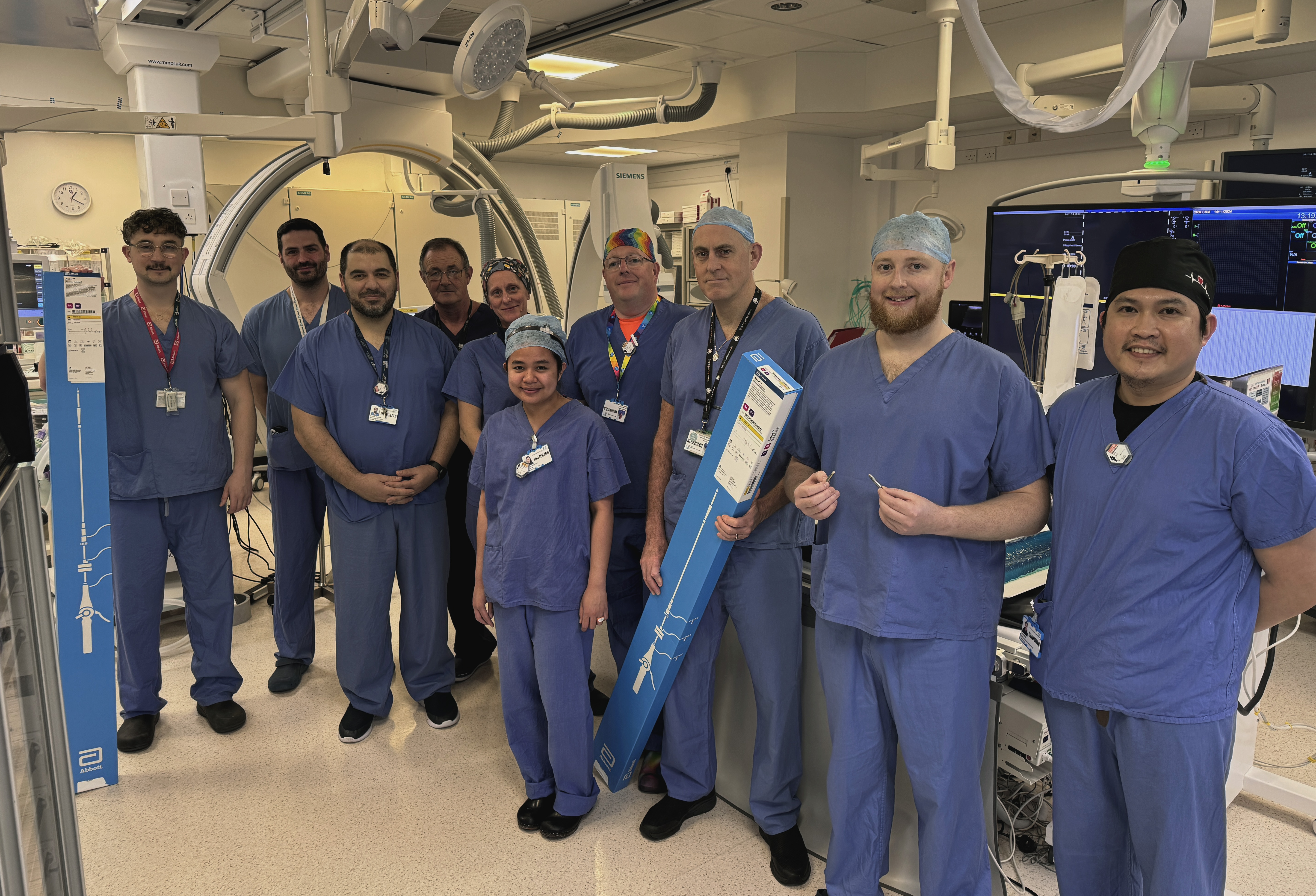Pioneering twin pacemaker system set to transform care for thousands of heart patients
Doctors at University Hospital Southampton (UHS) have carried out a pioneering dual-chamber pacemaker procedure which is set to transform the lives of thousands of patients suffering from irregular heart rhythms.
The revolutionary approach involves implanting two leadless devices, one in the right atrium and one in the right ventricle of the heart, for the first time. Previously only single leadless pacemakers were available.
The two devices communicate continuously with each other from different chambers using revolutionary implant-to-implant technology to sense and pace the heart, sending electrical impulses as needed to regulate rhythm.
Known as AVEIR DR, the system – the first of its kind in the world – has been hailed a “significant milestone” as it offers a potential solution for patients who have been unsuitable for a single pacemaker.
The pill-shaped devices, each smaller than a AAA battery, are leadless and therefore reduce the risk of complications often seen in people with traditional pacemakers.
In addition, with traditional pacemakers, wires are implanted under the skin which may lead to problems such as blood clots and infections and can require surgery within three years to replace.
Last week, 54-year-old Karen Cooper became the first patient at UHS to be fitted with the new device.
The minimally invasive procedure was carried out as a day case in around an hour via keyhole surgery using a specially designed catheter to implant the devices directly into the heart via a vein in the leg.
The surgical team mapped out the optimal location using radiology technology before implanting the first device into the right ventricle by screwing the spiral end into the heart tissue.
The second device was then implanted into the right atrium and testing was carried out to confirm successful connection between the two pacemakers.
The most common heart rhythm condition, atrial fibrillation (AF), affects around 1.4 million people in the UK. It can affect adults of any age, but it is more common in older men and is more likely to occur in people with other conditions, such as high blood pressure (hypertension), atherosclerosis or a heart valve problem.
UHS performs over 2,000 procedures for patients every year with a heart rhythm condition.

Ms Cooper, a single parent from Romsey, said: “I had my first pacemaker fitted when I was 17 after I fainted, resulting in a head injury. Doctors ran some tests, including an ECG, which picked up that I had a heart condition called arrhythmia – an irregular rhythm of my heart.
“I’ve had several problems with traditional pacemakers over the years and have had seven fitted altogether – mainly because of infections with the wires.
“The last one was changed as I ended up with a blood clot in my neck so a new pacemaker was fitted in my abdomen. This has also been causing me problems recently and having it changed again would require invasive surgery.
“When the clinical team mentioned the new dual-chamber leadless pacemaker it seemed like a game-changer to me.
“All the issues I have suffered with over the years and this new piece of kit could offer me peace of mind of the pacing but without the leads – I was over the moon at something that sounded like it would be life-changing for me.”
The use of the technology follows a global trial – published in the New England Journal of Medicine last year – that found the AVEIR DR has a 97 per cent success rate in returning a patient's heartbeat to normal.
In addition, the pacemakers are much smaller than traditional devices – each component is roughly one-tenth the size of a traditional pacemaker – with longer battery life.
There is little scarring from the procedure, no upper body restrictions post-surgery and the devices are engineered to be easily retrieved should a person’s therapy needs change or if a replacement device is required in the future.
Ms Cooper added: “I feel very lucky to be the first person in Southampton to receive the AVEIR DR and am so grateful to all the team involved in caring for me – they have been wonderful. Having a pacemaker helps you to live a normal life and I know it has certainly saved mine.”
Dr John Paisey, consultant cardiologist at UHS who led the clinical team, said: “This dual-chamber leadless pacemaker system represents a major leap forward in the treatment of certain heart conditions. It can be a more effective solution for some patients, improving their quality of life and potentially reducing some of the risks associated with traditional pacemakers.
“This has opened up doors for those who require dual-pacing treatment, meaning heart patients with certain conditions who weren’t eligible for the previous single leadless pacemaker may now have other options available to them which marks another significant milestone in cardiac care.”
Many of the patients who will benefit from the innovative implant will be living with chronic conditions such as congenital heart disease, kidney failure and problems with their immune systems.
Ross Campbell, general manager for cardiac rhythm management in the UK, Ireland and Germany for device manufacturers Abbott, said: “We’re pleased to see the first implants of Abbott’s AVEIR DR system taking place across the UK in hospitals like UHS, which is taking advantage of the latest technologies in heart health to provide the best care for their patients.
“Our ambition at Abbott is to develop life-changing and breakthrough technologies that transform the lives of patients for the better – and this project is one we’ve worked hard on to engineer. Thanks to the brilliant medical staff at UHS, patients across the south of England now have a solution that is built for their future.”
